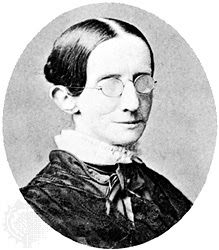
Her face was radiant with intelligence and pleasure. Her hair, braided by her own hands, was bound about a head, whose intellectual capacity and development were beautifully expressed in its graceful outline, and its broad open brow; her dress, arranged by herself, was a pattern of neatness and simplicity; the work she had knitted, lay beside her; her writingbook was on the desk she leaned upon.-From the mournful ruin of such bereavement, there had slowly risen up this tender, guileless, grateful-hearted being.
--Charles Dickens, on Laura Bridgman
Laura Dewey Bridgman (shown in a late-life portrait, above left) was born on this date in 1829, in Hanover, New Hampshire. She was the third child in a farm family, but when she was two years old, the older sisters died from scarlet fever; Laura survived, blind, deaf, and without her senses of taste or smell. The Bridgmans developed a set of home signs, for Laura to express her needs, and for her parents to make simple requests or give praise; by age 7, Laura had also learned to sew, knit, and make beds.
In 1837, Laura Bridgman was enrolled as a student at the Perkins School for the Blind in Boston, under the direct instruction of Samuel Gridley Howe. Howe saw in Bridgman a blank slate for proving theories of education and the mind; ignoring her earlier learning in the family home, he touted her as a perfect subject for his experiments in language. She learned to read raised-letter text fairly soon, and fingerspelling enough to communicate with others; Howe's reports include long quotes from their tutorial conversations. Howe made Bridgman a star attraction at the school's "Observation Days" events, where the public was invited to see the work of the school in exhibitions and tours. Charles Dickens made a visit to Perkins to see Laura Bridgman in 1842. A chapter of Dickens' American Notes is about Bridgman.
In 1843, Samuel Gridley Howe married Julia Ward, and left the day-to-day care and teaching of Laura Bridgman to his assistants; she became a teenager, no longer a sweet child, nor a novelty to the public. She had learned a great deal, but did not show the spark of genius Howe hoped to find, and he was disappointed in his project. She tried to return to her family in New Hampshire, but none of them could fingerspell with her, and she eventually lived at Perkins for
the rest of her life, helping around the school, teaching some. Late in her life, Laura Bridgman met young Helen Keller, when she came to Perkins; the rather formal New Englander scolded the boisterous Southern girl to "wash your hands," and complained afterwards that Keller had untidy fingernails.
In 2002, Bridgman was the subject of two new book-length biographies:
Elisabeth Gitter, The Imprisoned Guest: Samuel Howe and Laura Bridgman, the Original Deaf-Blind Girl (Farrar Straus Giroux 2002).
Ernest Freeberg, The Education of Laura Bridgman: The First Deaf and Blind Person to Learn Language (Harvard University Press 2002).
See also:
Douglas C. Baynton, "Laura Bridgman and the History of Disability," Reviews in American History 30(2)(2002): 227-235. [a review of Gitter and Freeberg]
Ernest Freeberg, "'An Object of Peculiar Interest': The Education of Laura Bridgman," Church History 61(2)(June 1992): 191-205.
No comments:
Post a Comment